#mme de pompadour
Explore tagged Tumblr posts
Text

11 notes
·
View notes
Text
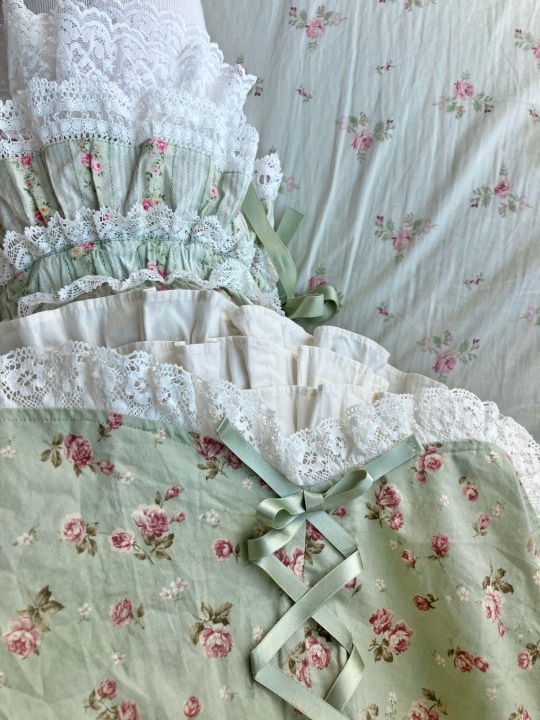

#lolita fashion#innocent world#metamorphose temps de fille#cottagecore#cottagecore fashion#dollcore#mine#pink + green roses is one of my favorite color combos ever I think#iconic it’s in so many rococo paintings#you know it’s good when mme de pompadour wore it#Dress: IW rose scallop frill Bloomers: Meta cotton dolly drawers Socks: Meta#the bedspread is vintage
419 notes
·
View notes
Text
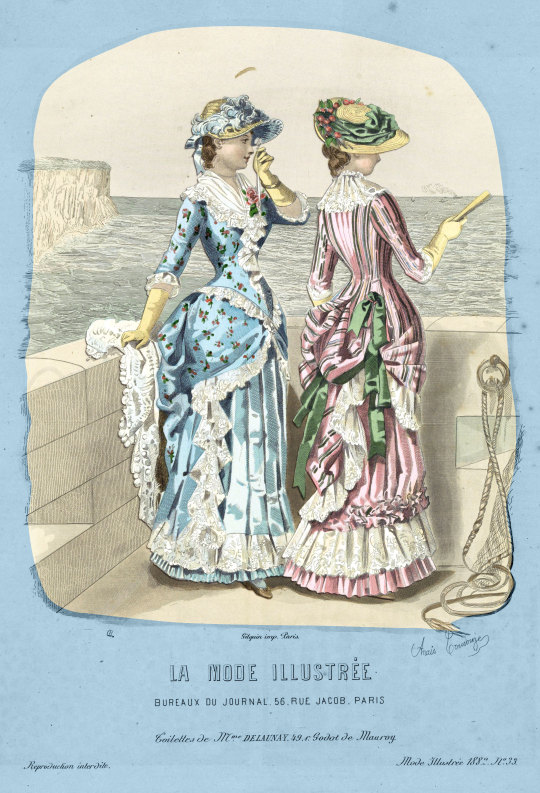
La Mode illustrée, no. 33, 13 août 1882, Paris. Toilettes de Mme Delaunay, 49, r. Godot de Mauroy. Collection of the Rijksmuseum, Netherlands
Robe en voile double bleu à petits bouquets Pompadour et rhadamès bleu. La jupe, plissée perpendiculairement, est faite en rhadamès; son bord inférieur est garni d'un petit volant plissé de même étoffe, à demi voilé par une grosse guipure posée à plat. Corsage et très-longs paniers, en voile double; les paniers sont garnis de même guipure, laquelle se retrouve sous le contour inférieur du corsage à pointe. Fichu bouffant en mousseline blanche garni de grosse guipure, laquelle se continue devant en forme de jabot. Manches demi-courtes, gants très-longs.
Dress in blue double voile with small Pompadour bouquets and blue rhadamès. The skirt, pleated perpendicularly, is made of rhadamès; its lower edge is trimmed with a small pleated flounce of the same fabric, half veiled by a large guipure laid flat. Bodice and very long panniers, in double voile; the panniers are trimmed with the same guipure, which is found under the lower contour of the pointed bodice. Bouffant fichu in white muslin trimmed with large guipure, which continues in front in the shape of a jabot. Half-short sleeves, very long gloves.
—
Costume en surah rose uni et satin rose à rayures algériennes, olive, bleu, rouge et or. La jupe, faite en surah, est plissée perpendiculairement; ces plis sont fixés à mi-jambe par une grosse ruche faite avec le satin rayé; cette ruche surmonte un volant de dentelle blanche. Polonaise en satin rayé garnie d'une même dentelle et drapée derrière à l'aide de longs nœuds en ruban olive, à double face rouge. Manches demi-longues. Gants très-longs.
Suit in plain pink surah and pink satin with Algerian, olive, blue, red and gold stripes. The skirt, made of surah, is pleated perpendicularly; these pleats are fixed at mid-leg by a large ruffle made with striped satin; this ruffle surmounts a flounce of white lace. Polonaise in striped satin trimmed with the same lace and draped behind with long bows in olive ribbon, with double red face. Half-long sleeves. Very long gloves.
#La Mode illustrée#19th century#1880s#1882#on this day#August 13#periodical#fashion#fashion plate#color#description#rijksmuseum#dress#bustle#suit#flowers#Modèles de chez#Madame Delaunay
74 notes
·
View notes
Text

All I'm saying is Aziraphale deserves a kiss rivalling Mme de Pompadour's. That's not asking too much, right?
#Aziraphale#Crowley#Fix it#the kiss#a good snog will help#help#good omens#brainrot#doctor who gifs#ineffable husbands#david tennant#ineffable idiots#michael sheen#gomens#good omens 2
117 notes
·
View notes
Text
MME DE POMPADOUR MENTION IN VENUS IN FURS ‼️‼️‼️‼️
11 notes
·
View notes
Text
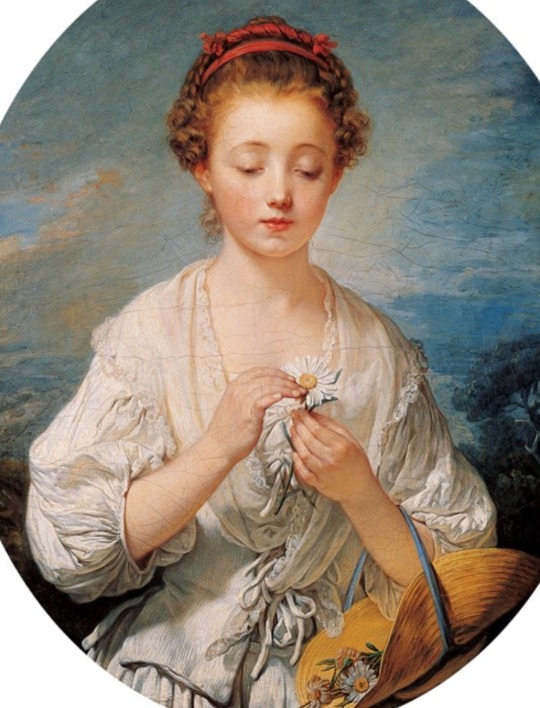
La Simplicité (Simplicity), par Jean-Baptiste Greuze, 1759, Kimbell Art Museum.
Commandé à Greuze en 1755 pour les appartements de Mme de Pompadour (maîtresse de Louis XV) à Versailles.
#simplicity#la simplicité#beauty#woman#portrait#jean baptiste greuze#art#painting#french art#french painting#18th century#18eme siecle#jeunesse#youth#Marguerite#pompadour#madame de pompadour#versailles#louis xv#mine
8 notes
·
View notes
Text
zira deserves a kiss rivalling mme de pompadour's
that's not asking too much, right?
#good omens#doctor who#10th doctor#crowley#aziracrow#aziraphale#ziracrow#crowley x aziraphale#good omens text
17 notes
·
View notes
Photo

Presentation of the Young Mozart to Mme De Pompadour at Versailles in 1763
10 notes
·
View notes
Text
"Les Bijoux indiscrets", de Diderot : cris et chuchotis
0 notes
Note
for the lolita fashion ask: 1, 11, 19 💗
Thank you for the asks!! ૮꒰ྀི >⸝⸝⸝< ꒱ྀིა
1: how and when did you first get introduced to the fashion?
I don’t know how I first learned lolita existed- probably through anime tbh- but I remember getting into it through 2 things; I was browsing Pinterest for historical costuming ideas and I kept seeing these Rococo and Victorian dresses, except they were super short for ballgowns which really confused me (I didn’t figure out that they were lolita but I thought they were so pretty) and second- I saw a girl wearing lolita on my college campus! I wore casual jfashion at the time (Liz Lisa, etc) but even though I knew what lolita was it felt super out of reach and like something only girls in Japan could wear. But there she was, in real life! It was a magical moment. I wish I could remember what exactly she was wearing or that I’d gotten a chance to meet her again but she completely changed my life! I put two and two together and realized I could wear these Victorian-esque dresses myself 🥰
11: what's one item you have that you would never sell?
This is tough, I have a lot of things I really love… I think probably my IW Renoir OP though. It’s definitely the dress I wear the most (it layers really well with like half my closet too..) and unlike a lot of other pieces I love I wouldn’t be able to sell it for a lot of money either.

Like, I would never want to sell my usakumya or my Milky Chan JSK but if I was in a bind financially they could be worth a couple hundred dollars each so if I had to it would make the most sense yknow?
I’d never want to sell my parasol either as it was a gift from my mom <3 and I have a couple vintage Gunne Sax pieces I’d never sell because with how popular the brand has gotten I’d never be able to replace them 😅 and I wear my Gunne blouses constantly too…
19: do you remember the first dress you ever saw? do you still like it?
Angelic Pretty’s Pompadour OP! I remember coming across it and not even realizing it was lolita, just thinking ‘huh someone made a version of Mme de Pompadour’s gown but they cut it so short, I wonder why’ haha. I’d love to own this dress! I’m a huge fan of the original painting and I think the color combo and design is so pretty. It would be a really nice convention/fancy tea party piece.
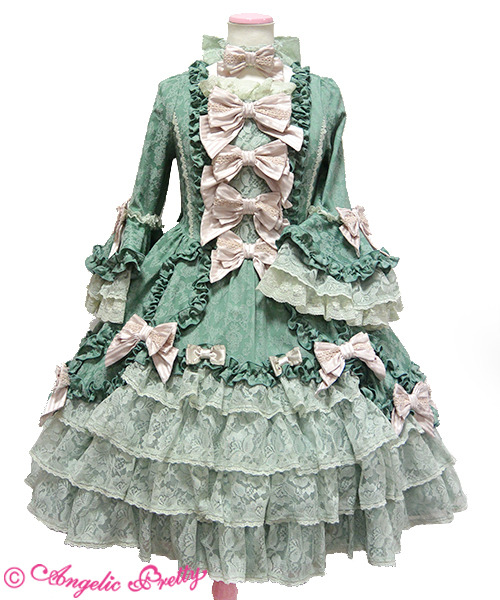
#mine#askbox#sadly mystery lolita chan was not in my comm and I never saw her again#just a mystery angel come to give me the gift of lolita lol#I don’t even remember what she wore I just remember it was navy colored#oh and I’d never sell my bunny chan coat! forgot about that#it’s just too cute I can’t let go of bunny chan…#probably also my Chelsea JSK not just because I love it but because it’s damaged too lol#so like she’s only worth anything to me but I love her#I don’t know if I’d say the Renoir OP is my favorite dress but it’s probably the one I’d save first in an emergency lol#it goes with everything and is so comfy#like that would be what I’d wear if I were a cartoon with one outfit yknow#(although I think giving a lolita only one outfit is a crime but w/e)#also yeah I probably found out about lolita through anime sorry lol#I had a middle school weeb phase like everyone else#I don’t think it’s a bad thing to be into lolita fashion and anime either as long as you realize most anime outfits aren’t actually lolita#is there still a stigma about that? there was when I started#also like I mean ‘short’ for pompadour in the sense of compared to floor length#bc I thought it was an attempt at historical fashion and not lolita lol#sorry for the essay haha
8 notes
·
View notes
Text


Le Petit écho de la mode, no. 7, vol. 19, 14 février 1897, Paris. Un Taglioni. Ville de Paris / Bibliothèque Forney
Une création nouvelle qui lait sensation dans le monde coquet, c'est le nouveau Jupon Pompadour de Mme Desbruères. La charmante artiste, loin de clore la série de ses succès, ajoute journellement une œuvre nouvelle à son répertoire féminin, nulle ne sait comme elle, tenir en haleine la coquetterie parisienne Ce joli croquis de jupon ne donne qu’une idée imparfaite de ce froufrou de tissu fleuri. Un grand volant de mousseline de soie crème faisant transparent est traversé d’une dégringolade de velours entrelacés de plis mignons. A la naissance des volants, un bouillonné avec flot de rubans. Il n’est en vérité que la maison Jeanne d’Arc pour imprimer autant de piquant à la toilette intime. Ajoutons que les modèles sont, jolis à 30, 40 et 50 francs, mais qu’à partir de 60, 70, 80 et 100 francs, ils sont merveilleux. Sur demande nos lectrices recevront gratis et franco le nouvel album illustré, contenant tous les modèles de jupons Taglioni, corsets, lingerie, trousseaux, il suffit d’écrire à la maison Jeanne d'Arc, 268, rue Saint-Honoré, Paris.
A new creation that is causing a sensation in the world of coquetry is the new Pompadour petticoat by Mme Desbruères. The charming artist, far from closing the series of her successes, adds a new work to her feminine repertoire every day; no one knows how to keep Parisian coquetry in suspense like she does. This pretty sketch of a petticoat gives only an imperfect idea of this rustle of flowered fabric. A large flounce of cream silk muslin that is transparent is crossed by a tumble of velvet interwoven with cute folds. At the base of the flounces, a bubble with a flood of ribbons. In truth, only the house of Jeanne d'Arc can give so much spice to intimate apparel. Let us add that the models are pretty at 30, 40 and 50 francs, but that from 60, 70, 80 and 100 francs, they are marvelous. On request our readers will receive free of charge the new illustrated album, containing all the models of Taglioni petticoats, corsets, lingerie, and trousseaux, just write to the house of Jeanne d'Arc, 268, rue Saint-Honoré, Paris.
#Le Petit écho de la mode#19th century#1890s#1897#on this day#February 14#periodical#fashion#fashion plate#description#Forney#dress#petticoat#gigot#matinee#one color plates#Modèles de chez#Maison Jeanne d'Arc#fav february
14 notes
·
View notes
Note

Crowley lookalike with Mme. De Pompadour (Sophia Myles) on Doctor Who episode, “Girl in the Fireplace.”
There's something about Crowley with a pompadour that I find rather interesting.🤔


There's something very funny to me about Crowley as the originator of the pompadour and then having tacky, wannabe Louis XIV-style furniture in S1, since the humans attribute his hair style to Louis XIV's mistress, Madame de Pompadour (who may or may not have been a certain ginger we all know but at least knew of him.) What, exactly, was Crowley up to with the French court in the 1750s/early 1760s that led to that ripoff throne-level of saltiness? Also very funny that Crowley was tall hair deep in the sex lives of the French royals and then look who suddenly went to night school to brush up on his French wordplay skills in 1760 😂

93 notes
·
View notes
Text
The way that the Lyndamine AU (genderswap V) is literally just Mme de Pompadour
0 notes
Text
Madame Putiphar Groupread. Book Four, Chapter I
𝔗𝔥𝔢 ℜ𝔢𝔱𝔲𝔯𝔫 𝔬𝔣 𝔉𝔞𝔱𝔥𝔢𝔯 𝔇𝔦𝔩𝔩𝔬𝔫
(clickbaity title. Did you know Borel’s Irish Priest DILF was a real person, you can see him here and wonder with me about Borel’s taste in men)
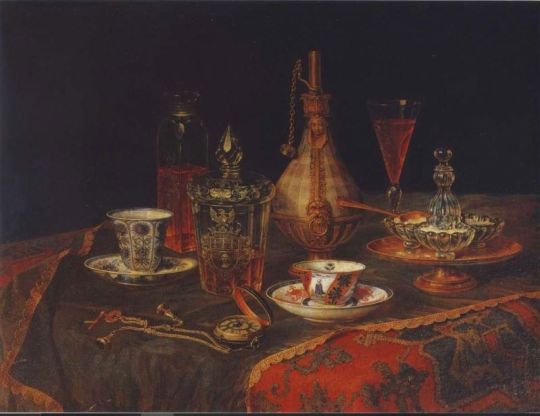
Berentz Christian, Still life with bohemian chrystals, cups and a pocketwatch , oil on canvas, 1700-1720
{ @sainteverge + @counterwiddershins }
The King and Pompadour are sitting by the fireplace (in shape of an arc d’amour. this is romanticism, anything that can be symbolic will be so. I choose to believe this is a tacky, slightly pinkish vaginal adjacent architectural creation, because sometimes my brain gets art directed by Ken Russel's team. I looked up the term to see if this is an architectural term, and it still might be, but it also could be a Roman de la Rose reference, a degraded reference to the arc of pure love that appears in the novel’s House of Fortune)
Madame P and her King act like a parody of bourgeois domesticity. She knits, he tries to tolerate a heavy indigestion. they both yawn because yawning is contagoius. We see the King has changed shapes once again, as a character whose physical form relfects his inner emotions, he is back into his grotesque, weak, flaccid, deflated frame. His mistress playfully suggests a requiem might be in order. She chides him for being so uncultured (the King believes music to be harmful for adult males) Mme P is an enjoyer of the Luminaries of the Enlightenment, as we know, on a shallow level, so she chooses to entertain the King with some base gossip instead of a selection of arias in languedoc. Father Dillon, Patrick’s old would be protector, reappears, at least in name only. It’s fun to see him again, this time not through Patrick’s naif vision… why do we see him again though? He is an example of an assimilated irishman, and being so high up in the clergy he is well connected enough that mm p and pharao casually gossip about him and his money. He is not alone but an atom in the circles of aristocratic libertinism, and although this game is harmless and stupid (basically here to illustrate how base the people high up are, and how money mixes up into their sexualized games, mme p fake reads the enlightenment and her partenaire claims music is harmful, and both can only bare talk about sex and money. Once again the supervillains of this novel are as banal as they can be, nothing is remarkable about them-mme p is as least a skilled social climber/a good lover etc-and these mediocre beings are tasked with destroying the lives of the much worthier novel’s heroes)(which honestly makes them very Roman and very contemporary) borel seems to be saying, no one so high up is clean.
But not even Mme P’s boob size contest story can disipate the clouds of annoyance darkening Pharaoh’s brow. She notices this, and her tone shifts to a submissive one -we understand how clever she is in testing the royal mood’s waters- The King confesses he’ll break under the weight of the scepter… He wishes to abdicate, because governing a people is too much work. What caused this crisis? His nightime snack wasn’t served, lunch had been detestable. So, the people he governs are basically, only his servants, the royal scope is as narrow as a long-lens. He governs to be served. Simple as that. The people, he complains, no longer have a vocation of service, and it’s all the fault of those meddling Philosophers who desacralize everything.
To highlight how deflated the King is in his current presentation, Borel displays him completely helpless or unwilling to exert direct violence as we have seen before. He asks mme P to avenge him because the new girl on “the Parc” has affronted him. Deborah’s curse, and unsubmissiveness/resistance to him, have left an impression on the King. Are we to believe most women on the parc choose to be nice to the King, play the game in hopes of a confortable life/social ascent?
Pompadour suggests Deborah cannot stay in the Parc, but, being also unfit for life in society, she must be locked in the most secret royal prison. Madame P assures the King his people haven’t forgotten how to serve him, Deborah is after all, a foreigner, which should explain her uncouthness/ignorance. She is a virago and a savage. She is worth much less than the average french subject. Like a new Scherezade, Pompadour prepares some coffee (distracting the royal baby with the shiny marabout) and resumes her role as a story teller.
6 notes
·
View notes
Photo

Study of the Left Hand of Madame de Pompadour, Francois Boucher, 18th Century
#Study of the Left hand of madame de pompadour#mme de pompadour#madame de pompadour#francois boucher#boucher#study#drawing#art#1700s#18th century#rococo
71 notes
·
View notes
Text
This is what I’ve been saying. Was he in love with Rose? (I know a good percentage of the fandom thinks yes.) Let’s not forget that he was willing to leave her for Mme. de Pompadour, or at least not too upset about the circumstance.
And let’s not forget that he tried to send her to be cut off in a parallel world with her mother, not-father, and Mickey, with no qualms until she refused to go. If Rose had not refused, she would still have been in the parallel world, but would the Doctor have been feeling so sad? Or guilty?
did the doctor keep bringing up rose because he was just that heartbroken or because he had to keep reminding himself about her so he didn’t go falling in love with the gorgeous medical student who keeps saving his life? 🤨
62 notes
·
View notes